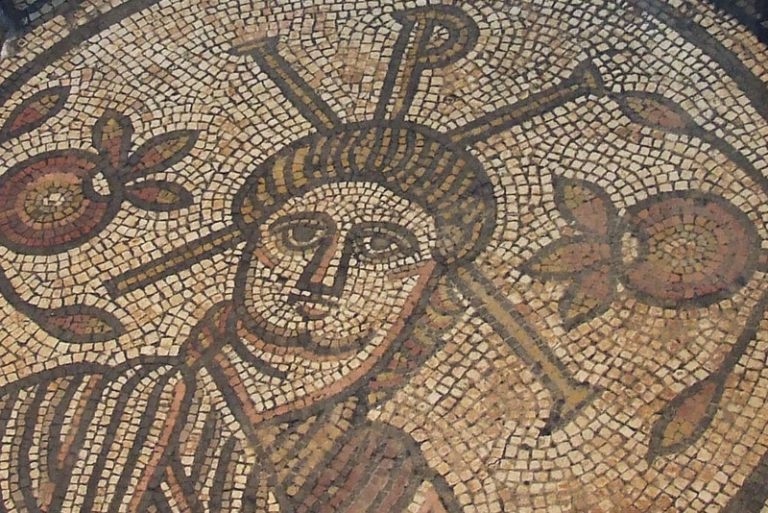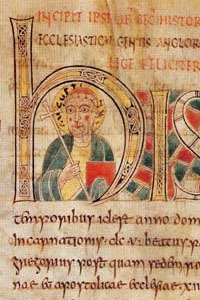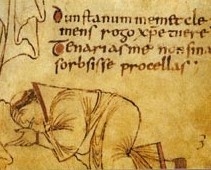
Christianity in Roman Britain
We cannot tell exactly when Christianity first came to Britian. There are some very early writings about missionary travels which may refer to the British Isles, but there is little certainty. About the year 70, Clement who was then Bishop of Rome, wrote that St. Paul went 「to the extreme limits of the West.」 Irenaeus wrote about 180 that Christianity had already been taught 「among the Germans and Britons.」 Then about 208, Tertullian remarked that 「some countries of the Britons」 were subject to Christ. However, in those days, words which we might translate as 「Celts」 or 「Britons」 were used so loosely for different peoples of northern or western Europe that it is sometimes impossible to be certain which were meant.
There is, however, one date which stands out definitely: in the year 314 three British bishops (Eborius, Bishop of York, Restitutus, Bishop of London, and Adelphius, Bishop of Caerleon-on-Usk) attended a Church council at Arles in southern France. The ‘canons’ or rules adopted by that council are signed by the three British bishops, as well as by a priest and a deacon who accompanied them to on their trip. For the next hundred or so years, the British Church remained in contact with the Continent and life in the province continued along Roman lines. Germanus of Auxerre visited Britain in 429, and it is possible that around this time, St. Patrick (who was a Briton himself) prepared for his mission to the Irish by visiting the great monastery of Lérins in southern Gaul.
About the year 449, the country which we now know as England was invaded by the barbarian tribes of Angles, Saxons and Jutes. No doubt many of the Christian Celtic inhabitants were killed by those Anglo-Saxon invaders, while others were driven off to more remote parts of the British Isles–to Scotland, Wales, and Ireland. Many took refuge in the western part of France settling in that part called Brittany. The disruption to the Roman way life was significant, and many religious sites were plundered or fell into neglect. The British monk, Gildas, paints a picture of a violent and crumbling society, where petty kings warred against one another and the church struggled with corruption and vice. Yet despite the coming of hard times, the Christian faith was never completely extinguished in the British Isles, as evidenced by its contact with the Gregorian mission in the following century.

The Conversion of the English
The next date of which we can be sure is 597. In that year, St. Augustine and about forty others were sent from Rome as missionaries to the Anglo-Saxons. By that time the pagan invaders had occupied the better part of what is now England. Augustine and his companions settled in Canterbury. There they found St. Martin’s Church already established, and being used as a place of worship by Aldeberge, Queen of Kent. She was a Christian princess who had come from France to marry the Ethelbert, High King of the Anglo-Saxons. Within a short time, under her influence and that of Augustine, the king himself consented to be baptized, and so began the conversion of the Anglo-Saxon peoples in the south. Following his success in Kent, Augustine was elevated to archepiscopal rank and became the first Archbishop of Canterbury. As the prestige of this office spread, so too did its influence, and the Archbishops of Canterbury were eventually recognized as the leaders of the English Church.
In the meantime, others were working to evangelize the north. Paulinus of York had converted Edwin, King of Northumbria, to Christianity in 627, but following his death at the Battle of Hatfield Chase, the kingdom slipped back into paganism. It was not until the Irish monks of Iona were invited into Northumbria by King Oswald in 634 that the faith became firmly established. St. Aidan, who was renowned for his humility and piety, converted many thousands through his interaction with the common people, and his monastic foundation at Lindisfarne became a center of learning for years to come. The success of the Church in this era can in large part be traced to the faith and determination of its leaders, a list that includes such names as Benedict Biscop, Cuthbert of Lindisfarne, Hilda of Whitby, John Beverley, and Wilfrid of York.
Admittedly, there were differences between the Roman and Celtic missions. Some were minor, such as the style of the monastic tonsure, but others were more significant, such as the method for calculating the date of Easter. Thus the Northumbrian King, Oswiu, who was brought up by churchmen of the Celtic tradition, might be celebrating Easter, while his queen, a princess of Kent and adherent of the Roman method, would still be observing Palm Sunday. This caused some consternation and conflict until the matter was resolved by the work begun at the Council of Whitby in 663, and continued at the Council of Hertford ten years later. At that time the union of the Churches became known as Ecclesia Anglicana, or the Church of England.
The Anglo-Saxon Era
In the 8th century, the English Church continued to grow. The great monastery of St. Peter at Monkwearmouth was a center of light and learning. It was there that the Venerable Bede completed his Ecclesiastical History of the English People, one of our best sources for the era of conversion. Monks at Jarrow also contributed to the intellectual life of the English Church through their development of various miniscule scripts, which greatly aided the process of book copying and production. The great scholar, Alcuin of York, was renowned for his learning and piety, and after settling in Charlemagne’s capital at Aachen, became a major figure within the Carolingian Renaissance. Sts. Willibrord and Boniface worked on the Continent as well, serving as missionaries to the still pagan Frisians.
This golden age was not to last though, as Viking raiders discovered that the monasteries of Northumbria were rich prizes. Isolated raids led to conquest and settlement, and over the course of the 9th century the Christian kingdoms of the north and midlands fell one by one. In the south, however, Alfred the Great’s Wessex held out, and following his victory at Edington in 878, he forced the Danish leader, Guthrum, to be baptized and open up the conquered territory to Christian missionaries. Gradually the English kingdoms and the Danelaw were united, and by the time of Edward the Confessor (1042-1066), England’s boundaries came to approximate what they are today.

The latter part of the Anglo-Saxon era was a time of consolidation and reform in the English Church. As Archbishop of Canterbury, St. Dustan (909-988) worked to improve the level of education among the clergy, while his counterpart at York, St. Oswald, founded new monasteries and improved ecclesiastical organization. Less well known, but still important to the Church’s cause, were Aelfric of Cerne and Wulfstan of York, both of whom were active homilists and teachers. Edward the Martyr and Edward the Confessor were two royal saints of the period, as was Edith of Wilton, a nun of great piety and learning.
By the time of the Norman Conqest, the English Church was well established and had a long history of scholarship and evangelism. With the coming of the Conqueror, however, the English Church would enter a long period of reorganization. The Conquest happened to coincide with one of the great periods of reform in the history of the Church. The Gregorian Reform movement (named after Pope Gregory VII, 1073-1085) sought to define and consolidate the rights of the Church vis-a-vis secular rulers and worked to curb abuses such as simony and concubinage. This campaign also resulted in a greatly strengthened papacy, which would over time, come into conflict with both princes and prelates outside Rome, and the British Isles were no exeption. Though Roman influence was widespread during the High Middle Ages, we also see at various times strong assertions of the rights and privileges of the native English Church.